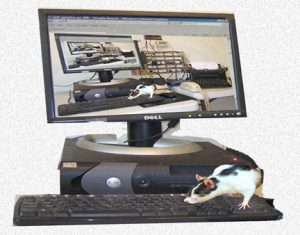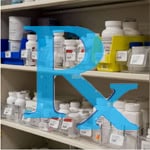Chronic Kidney Disease In Your Pet Rat – What It Is, And What You Can Do About It
Ron Hines DVM PhD
Chronic Kidney disease in rats goes by more names than a rat has whiskers.
Kidney failure is very common in elderly rats. Only tumors and mycoplasma-related lung disease outnumber the cases of kidney failure that I see.
Kidney Disease
Depending on what aspect of the condition is being described and by whom, it is called chronic renal failure (CRF), chronic progressive nephropathy (CPN), progressive glomerulonephrosis (PGN), rat nephropathy, chronic progressive nephrosis, chronic glomerulonephropathy ,Spontaneous degenerative nephropathy ,glomerulonephrosis , glomerulonephritis ,chronic interstitial nephritis, Chronic nephrosis, renal insufficiency ,chronic uremia, protein overload nephropathy, old rat nephropathy, etc. A different kidney problem, polycystic kidney disease, also occasional affects, humans, cats and dogs.
Your rat’s two kidneys are composed of millions of tiny filtering structures called glomeruli. When your rat is born, it has about 34,000 of these structures in each of its kidneys. As your rat ages, it is normal for some glomeruli to be lost to scaring and inflammation. It happens in all of us. All normal animals are born with considerably more glomeruli than they need to maintain healthy bodies. But when only a quarter of the number remain, the signs of CRF begin. You can read an interesting study on this gradual decline in glomeruli numbers in the kidneys of rats. (ask me for Heilmann2012)
As blood passes through these filters (glomeruli) , the waste products of protein metabolism are collected and excreted by them and their accessory structures (ref) into the rat’s urine. These filters also regulate the amount of water and minerals (electrolytes) present in the animal’s body.
 What Happens When A Rat’s Kidneys Begin To Fail?
What Happens When A Rat’s Kidneys Begin To Fail?
The gradual loss of kidney tissue in rats appears to be primarily due to chronic inflammation. Chronic inflammation gradually destroys the urine-producing glomeruli , the structural tissues that surround them (interstitial nephritis), conduits (nephrons) that convey the urine out of the kidneys and eventually replaces these structures with non-functional scar tissue (fibrosis).
Veterinarians and physicians track a kidney’s declining function by tracking the rise in two waste products of metabolism found in the blood, urea nitrogen (BUN) and creatinine. Blood urea nitrogen and creatinine levels in healthy rats are about 12-20mg/dL (=deciliter) and 0.3-0.4mg/dL respectively. Even when BUN levels rise to 30-40mg/dL, the rat will probably appear fine. But when BUN levels exceed that (when approximately 2/3 – 3/4 of the glomeruli have been lost), the pet’s general health will begin to suffer. Blood urea nitrogen and creatinine are just two of a very large group of waste products that begin to accumulate when the kidneys can no longer purge them from the body. They just happen to be the two that are most convenient to track.
Rats with kidney problems are generally quite thin. They are not as active as they once where and have a general appearance of ill health (malaise). Much of that malaise is due to high levels of toxins circulating in their blood stream because their kidneys are no longer capable of removing those toxins from their body. The situation is called uremia or azotemia. Read about that situation in other pets here. A North Carolina study tracked how this occurs in the rat with phenomenally detailed photographs. You can view it if you ask me for (Xie2012.pdf)
 What Signs Might I See If My Pet Rat Has Kidney Disease?
What Signs Might I See If My Pet Rat Has Kidney Disease?
The first sign you will probably notice is that your rat’s water bottle is emptying faster than it once did. You might also notice that the bedding is staying damper in its litter boxes and cage corners. Both are occurring as your rat consumes more water to compensate for its failing kidneys. With fewer remaining glomeruli filters, it must pass more water through the remaining ones in order to keep its blood clean.
The next common symptom of kidney disease is a slow decline in body weight – even if your rat appears to be eating sufficiently. This is due to the general malaise of early uremia combined with body changes that include an increase in blood acidity (metabolic acidosis) and anemia. The kidneys of rats (and all mammals) produce a hormone, erythropoietin (EPO), necessary for red blood cell formation. This hormone is no longer produced in sufficient quantity by the scared kidneys of rats suffering from chronic renal failure. (ask me for Sanada2009) Due to the gradually increasing anemia, you might notice that your rat’s toes and ears are paler than they once were and that it is breathing faster.
With time, your rat’s activity level will decrease and other disturbances will begin. When kidneys can no longer keep blood phosphorus levels in control, a condition called secondary hyperparathyroidism develops.
Those rats can show rear leg weakness, soft bones, diarrhea, and ,eventually, seizures.
Blood pressure will also be increasing in your rat as well as renin production in its kidneys decreases. Renin is essential to the regulation of blood pressure. (read here)
Sometimes, periods of sickness develop after stresses such as boarding, the addition of new rats to the cage, etc. Periods of stress like those can cause the rat to drink less water and make the problem get suddenly worse.
 Why Do Pet Rats Develop Kidney Disease So Frequently?
Why Do Pet Rats Develop Kidney Disease So Frequently?
Increased susceptibility to a disease is a matter of genetics. There is no evidence that wild rats have high levels of kidney disease. But domesticated rats are quite inbred , and inbreeding tends to bring out specific diseases. Most historians believe that rats were domesticated in Victorian England. At that time, unusually colored docile rats were in demand and the most common way to perpetuate unusual color patters and temperament is by brother-sister matings. You can read about the genetics of kidney disease in rats. (ask me for Garrett2010pdf) Even today, many rat breeders do not encourage out-breeding as seriously as they should. It has been a recognized goal in animal breeding for years. (read here)
Although its genetics make an animal predisposed to one disease or another, how we husbandry our animals makes those genetic dangers more (or less) apparent. Later in this article, I have some suggestions on how you can minimize the chances of your rat developing kidney disease at an early age.
 At What Age Do Rat Kidney Problems Generally Begin?
At What Age Do Rat Kidney Problems Generally Begin?
Kidney changes begin in domesticated rats at a very young age – it is not something you can prevent any more than you can stop the clock of time. Once a rat reaches 12 months of age, it is common to find the early signs of scaring and glomerular loss. Male rats seem to develop the problem early than female rats. There is considerable variation between rat strains as to the amount of change seen at a given age. In laboratory Wistar rats, small scared kidney areas or synechia begin even before the rat is mature. By 40 weeks of age, 64% of the Wistar rats had some evidence of kidney damage. By 50 weeks 76% did. You can read that article that tracks the beginnings and progression of kidney loss in rats here.
 What Tests Can My Veterinarian Run To Decide If My Rat’s Kidneys Are The Source Of Its Health Problems?
What Tests Can My Veterinarian Run To Decide If My Rat’s Kidneys Are The Source Of Its Health Problems?
A veterinarian can often palpate (feel) the small, hard, lumpy kidneys of renal disease in your rat’s abdomen during his/her examination.
Your vet might then check a few drops of your rat’s urine with a diagnostic paper strip (ref) to see if the urine contains too much protein. Protein leakage into the urine always occurs when kidney disease is advanced. Your vet might also note that the specific gravity of your rat’s urine is very low. Dilute urine, in the absence of other causes, is also a sign of kidney problems.
If your vet is suspicious of anemia and paleness, a sample of blood can be collected from a toenail saphenous veins or the tail vein and a packed red cell volume (PCV) determined while you wait. (Toenail blood is the least desirable for analysis but the easiest to obtain.)
If enough blood can be obtained for laboratory analysis, your vet will probably note that the rat’s blood protein levels (albumen) are lower than they should be and that its BUN and Creatinine levels (that measure kidney function) are above normal (azotemia). (From Benigni2011): Normal creatinine in rats is 0.7 mg/dL another source: creatinine normal range: 0.3-0.4mg/dL , BUN (normal range: 12-20mg/decileter) Blood phosphorus levels are usually increased as well.
We do not have safe methods to measure a rat blood pressure in animal hospital settings. But if we did, we would probably find that your rat had hypertension as well. The Systolic blood pressure (=the high number reading)of rats is about 87 mm. When elevated, the blood pressure of rats can reach 192 mm Hg. (Garrido2009.pdf)
There is another test that picks up kidney damage in rats long before BUN and Creatinine blood levels rise. It is the urine C-type natriuretic peptide (CNP) assay. I do not know of its commercial availability but you can read about it: (Sangaralingham2011)
 Might My Rat Need To Be Hospitalized?
Might My Rat Need To Be Hospitalized?
When rats are in the late stages of kidney failure, they often do not drink sufficient water.
The best way to provide these weakened animals with the fluids they need is to administer them subcutaneously (under the skin) or intraperitoneally (through a needle into their abdomens). That may not be something you would want to do at home although some rat owners have no problems with doing that. If your rat’s blood electrolytes are severely out of normal range, the fluids administered can be modified to correct body acidity, counteract shock, increase urination with diuretic drugs, and provide protective antibiotics – things you can not do with a bag of saline (PSS) you give at home. Severely ill rats might need supplemental oxygen and warmth – things also best done by an experienced staff at an animal hospital.
 Can Kidney Disease In Rats Be Cured?
Can Kidney Disease In Rats Be Cured?
Kidney disease in rats cannot be cured – but your rat’s life can be extended. If you catch the problem early enough some of the kidney changes might even be reversed. (Fukuda2011)
 What Treatments Are Available That Might Help My Pet Rat?
What Treatments Are Available That Might Help My Pet Rat?
We know more about kidney disease in rats than in any other animal species on the Planet. That is because they are the most common experimental animal used in kidney disease research.
Here are some things that scientists know that might have the potential to help:
(When you make modifications to your rat’s diet, don’t forget that rats need hard objects to gnaw on – my favorite are hard maple dowels )
Lowering Your Rat’s Protein Intake
Protein in your rat’s diet is the source of much of the waste that accumulates in its blood when its kidneys no longer have the capacity to remove it.
Normal rat chow sold in the United States has a protein content of about 23%, a fat content of about 6.5% and a fiber content of about 4.5%. We know that rats do quite well on half that amount of protein. They also experience less kidney disease on those diets. (Wang2011)
Unless you are breeding rats, there is no need to give them 23% protein at any stage of their life. You can lower your rat’s protein intake by diluting its rodent pellets with lower-protein ingredients such as aflatoxin-free corn and pasta.
Increasing Your Rat’s Carbohydrate and Selective Fat Intake
If you lower your rat’s protein intake by diluting its diet with high-carbohydrate ingredients,you will be providing it with increased carbohydrate. But studies have found that feeding rats a diet that is double the fat content of standard rodent chow also protects the kidneys. In one study, supplemental milk fat (essentially unsalted butter) added to a low protein/high carbohydrate diet slowed the progression of CRF in rats. You can read that study: (Kim2010.pdf). Don’t worry too much about the added fat calories – Studies show that in late kidney failure it is the thin rats that die first. Conjugated linoleic acids seem particularly beneficial. (Wakefield2011)
Controlling Your Rats Phosphorus Intake
When your rat’s kidneys can no longer remove excess phosphorus from the body, it accumulates in blood and body fluids, driving down the level of essential calcium. Another effect of CRD is that Vitamin D3 (calcitriol), essential for calcium absorption, is under-produced in failing kidneys. The condition produced is called nutritional secondary hyperparathyroidism. You can read about it as it occurs in rats with CRD. (Helvig2010)
You can help your rat by limiting the amount of phosphorus in its diet. For ideas on what common food ingredients are low in phosphorus, you can refer to an article you can ask me for: (Utah2008lowPdiet.pdf)
Controlling Your Rat’s Sodium (Salt) Intake
Kidney disease in rats is often accompanied by high blood pressure. Limiting the amount of salt that your rat consumes is the best way to deal with that. You can read about the effects of high salt diet on rats. (Pletinck2010)
Controlling The Total Calories Your Rat Consumes
Rats in decline with CRD need all the calories they can get. But rats in their youth and midlife tend to live longer and have delayed kidney problems when they are not fed all that they might be willing to eat. I once cared for 15,000 rats at the NIH used in aging-related studies. Many were used in studies that documented the life-extending effects of caloric restriction. You can read one of the papers that came out of our protein and caloric restriction studies. (Massaro1989)
The Importance Of Fluids And Hydration
It is important that all rats with have unlimited water available to them at all times. That is particularly true with rats that suffer from kidney disease. Only by consuming additional water can these rats make maximum use of whatever amount of filtering capacity their kidneys still maintain. Check your rats skin daily for “doughiness” or the consistency of bread dough and lack of “spring back” when it is gently pinched or lifted. A properly hydrated rat’s skin will return to its normal place quickly. Wrinkles and folds will stay in place longer when the animal is dehydrated.
Multiple water bottles in easily accessible locations and juicy fruits are an excellent source of added water. Certain additions to the water apparently aid in stabilizing CKD in laboratory rats – but they are well beyond the capacity of most pet owners and veterinarians to provide. (Zhu2011)
For Developing An Optimal Diet for your rat, this is the best reference I know of: ask me for Ratkidney-Rao2002pdf
 Are There Medications That Might Help My Rat?
Are There Medications That Might Help My Rat?
Medications to Increase Blood Flow Within Your Rat’s Kidneys
A study I mentioned earlier (ratkidney-Benigni2011.pdf) found that kidney condition improved in rats when they received an ACE inhibitor. These are compounds that decrease resistance to blood flow within the body. They are commonly used to decrease the work load on weakened hearts. The one used in this study was enalapril a drug commonly prescribed by physicians and veterinarians for heart disease in combination with a blood pressure lowering medication, lisinopril. You can go back to (Fukuda2011) for dosages used. A problem with the use of ACE inhibitors in kidney disease is that they effect circulation in various areas of the kidney differently and might cause more harm than good in late stages of the disease. The pets GFR (indirectly, the amount of urine produced) needs to be closely monitored while on ace inhibitors to be sure it does not decrease.
Oral Blood Toxin Adsorbents
When diet and added hydration can no longer control your rat’s BUN and Creatinine levels, studies in Japan found that CRF rats benefited from consuming an oral carbon adsorbent, AST-120. (Chiang2012, reToshimitsu1997) Adsorbents prevent the absorption of toxic bacterial products produced by your rat’s intestinal bacteria that contribute to the spectrum of uremic toxins. The product is available in the US: (AST-120.pdf)
Oral Phosphorus binders
Certain compounds called phosphate binders can block the absorption of phosphorus from foods within the digestive system. At one time, aluminum hydroxide was suggested. Dieticians now think that more modern products that are free of aluminum are safer. Some common ones are calcium acetate (PhosLo®) and sevelamer (Renagel®).
Added Dietary B-vitamins
Rats that are under stress and not eating well might benefit from added water soluble vitamins. They work as well when given orally as they do when injected. Be sure that formulations do not supply liver-toxic levels of vitamin A or D.
 Are There Medications My Rat Should Avoid?
Are There Medications My Rat Should Avoid?
Yes. Non-steroidal anti-inflammatory and pain control medications can do damage to your rat’s kidneys. Do not give your rat aspirin, ibuprofen, meloxicam (Metacam®) or NSAIs commonly prescribed to pets like carprofen (Rimadyl®).
Certain antibiotics (aminoglycocides) , such as gentamycin and amikacin, should also be avoided in rats with kidney disease.
 What About Nutritional Supplements?
What About Nutritional Supplements?
Anti-inflammatory Omega Fatty Acids
Some believe that the anti-inflammatory effects of Omega-3 fatty acids found in flax seed and fish oil fatty acids might decrease the inflammation that accompanies CRF in rats. A recent study tends to back that up. (read here)
Alpha Ketiosocaproate
When the protein content of rat diets is kept very low to combat uremia, some studies have found that supplementing the diet with alpha ketiosocaproate ketoacid seems to improve the rat’s general health. You can read about that effect in rats:(Gao2011) That product, sold as “KIC”, is available through bodybuilding supply outlets.
Potassium Citrate
Uremic rats suffer from high body acidity (acidosis). Compounds like potassium citrate tend to lower the body’s acidity (alkalization agents) . The product is available over-the-counter. You can read about its effects on rats with a specialized form of kidney damage (polycystic kidney disease) : (Tanner2998)
Avoiding Moldy Grain Toxins In Your Rat’s Diet
Commercial rodent diets are based on grain. The grains used in animal feeds are often of lower quality than those sold for human consumption. One contaminant that often routs substandard grain products into animal feed channels is a higher-than-desirable level of mold toxins called aflatoxins. You are always safer feeding your rats products fit for human consumption. When you can’t inquire as to the total aflatoxin levels in the diet you feed. If the manufacturers will not tell you, don’t feed that diet. I suggest you not feed products that exceed the European Unions maximum levels in products consumed by children. You can read about what aflatoxins can do to the kidneys of rats: (Al-Habib2007).
 Does The Amount Of Daily Exercise My Pet Rat Receives Affect Its Kidney Function?
Does The Amount Of Daily Exercise My Pet Rat Receives Affect Its Kidney Function?
Rats need exercise to maintain their general health. But the only study I know of that examined the effect of exercise on a rat’s kidneys did not find increased exercise beneficial to kindney health. You can read that study: (Moningka2011)
 Does My Rat’s Home Environment Play A Part In Its Susceptibility To Kidney Disease?
Does My Rat’s Home Environment Play A Part In Its Susceptibility To Kidney Disease?
There is no specific information available to me regarding that. We do know that small rat cages, cages with poor air circulation, dusty litter and cages that are not changed frequently incur a buildup of ammonia. That ammonia is known to make upper respiratory tract infections in rats worse. How high environmental ammonia levels might affect a rat’s kidneys is unknown, but there is some evidence that ammonia does affect a rat’s kidneys in deleterious ways (read here)
 What About My Rat’s Social Needs?
What About My Rat’s Social Needs?
Long-term health and long term loneliness do not coexist well together. Rats are social animals that enjoy each other’s company. Spending an hour or two with a pet rat is no substitute for social interactions with other rats. Rats just appear happier when kept as same-sex pairs. Even better, consider a group of three or four (read here)
 Are There Ways To Choose A Pet Rat That Is Less Likely To Develop Kidney Problem Early?
Are There Ways To Choose A Pet Rat That Is Less Likely To Develop Kidney Problem Early?
Look for a source of rats with a large gene pool. Not a colony of rats that started out with only one or two pairs. These rats tend to have the best selection of genes and the best long-term health. (Woods2010) There are exceptions. There are inbred rat lines that are known for their longevity. Those strains are not sold in pet stores. They are available only from breeders that supply research scientists (companies such as Labome and Charles River Breeders). The least desirable place to purchase a rat is from your local pet store or pet megastore. Also, the more a rats body type and appearance differs from that of its wild predecessors, the more likely it will be to suffer from genetically-based health concerns. Generally, female rats develop kidney problems at a bit older age than their male siblings. So consider the sex of the rat when you purchase it. Domesticated brown Norway rats tend to live the longest (a lifespan of 1072±228 days). They can be purchased from commercial breeders. (brownNorway.pdf) However, I dreaded caring for that strain at the NIH. They were spooky, easily startled and they bit me more than any of the other rat strains we maintained.
 Dear reader, Besides your donations, Visiting the products that Google chooses to display on this webpage helps me pay the cost of keeping this article on the Web. As you know, sites like mine that are not designed to make money are getting harder and harder to find. Best wishes, Ron Hines
Dear reader, Besides your donations, Visiting the products that Google chooses to display on this webpage helps me pay the cost of keeping this article on the Web. As you know, sites like mine that are not designed to make money are getting harder and harder to find. Best wishes, Ron Hines


 What Happens When A Rat’s Kidneys Begin To Fail?
What Happens When A Rat’s Kidneys Begin To Fail? What Signs Might I See If My Pet Rat Has Kidney Disease?
What Signs Might I See If My Pet Rat Has Kidney Disease? Why Do Pet Rats Develop Kidney Disease So Frequently?
Why Do Pet Rats Develop Kidney Disease So Frequently? At What Age Do Rat Kidney Problems Generally Begin?
At What Age Do Rat Kidney Problems Generally Begin? What Tests Can My Veterinarian Run To Decide If My Rat’s Kidneys Are The Source Of Its Health Problems?
What Tests Can My Veterinarian Run To Decide If My Rat’s Kidneys Are The Source Of Its Health Problems? Might My Rat Need To Be Hospitalized?
Might My Rat Need To Be Hospitalized? What Treatments Are Available That Might Help My Pet Rat?
What Treatments Are Available That Might Help My Pet Rat? Are There Medications That Might Help My Rat?
Are There Medications That Might Help My Rat?